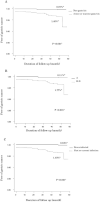Endoscopic evaluation by the Kyoto classification of gastritis combined with serum anti-Helicobacter pylori antibody testing reliably risk-stratifies subjects in a population-based gastric cancer screening program
- PMID: 37340218
- PMCID: PMC10423159
- DOI: 10.1007/s00535-023-02010-w
Endoscopic evaluation by the Kyoto classification of gastritis combined with serum anti-Helicobacter pylori antibody testing reliably risk-stratifies subjects in a population-based gastric cancer screening program
Abstract
Background: We previously demonstrated that the Kyoto classification of gastritis was useful for judging the status of Helicobacter pylori infection in a population-based screening program, and that adding H. pylori antibody test improved its accuracy (UMIN000028629). Here, we tested whether our endoscopic diagnosis of H. pylori infection status reliably estimated gastric cancer risk in the program.
Methods: Data were collected from1345 subjects who underwent endoscopic follow-up 4 years after the end of the registration. We analyzed the association of three diagnostic methods of H. pylori infection with gastric cancer detection: (1) endoscopic diagnosis based on the Kyoto classification of gastritis; (2) serum diagnosis according to the ABC method (H. pylori antibody and pepsinogen I and II); and (3) endoscopic diagnosis together with H. pylori antibody test.
Results: During the follow-up, 19 cases of gastric cancer were detected. By Kaplan-Meier analysis, the detection rates of cancer were significantly higher in the past or current H. pylori infection groups than in the never-infected group with all 3 methods. By the Cox proportional hazards model, the hazard ratio for cancer detection was highest in evaluation with the combined endoscopic diagnosis and the antibody test (method 3; hazard ratio 22.6, 95% confidence interval 2.99-171) among the three methods (the endoscopic diagnosis (method 1); 11.3, 2.58-49.8, and the ABC method (method 2); 7.52, 2.49-22.7).
Conclusions: Endoscopic evaluation of H. pylori status with the Kyoto classification of gastritis, especially combined with serum anti-Helicobacter pylori antibody testing, reliably risk-stratified subjects in a population-based gastric cancer screening program.
Keywords: Atrophic gastritis; Cancer screening; Gastric cancer; Gastrointestinal endoscopy; Helicobacter pylori.
© 2023. The Author(s).
Conflict of interest statement
The authors have nothing to disclose.
Figures



Similar articles
-
Feasibility of endoscopic evaluation of Helicobacter pylori infection status by using the Kyoto classification of gastritis in the population-based gastric cancer screening program: A prospective cohort study.Health Sci Rep. 2021 Jul 14;4(3):e325. doi: 10.1002/hsr2.325. eCollection 2021 Sep. Health Sci Rep. 2021. PMID: 34277955 Free PMC article.
-
Cancer development based on chronic active gastritis and resulting gastric atrophy as assessed by serum levels of pepsinogen and Helicobacter pylori antibody titer.Int J Cancer. 2014 Mar 15;134(6):1445-57. doi: 10.1002/ijc.28470. Epub 2013 Oct 3. Int J Cancer. 2014. PMID: 24009139
-
Development of gastric cancer in nonatrophic stomach with highly active inflammation identified by serum levels of pepsinogen and Helicobacter pylori antibody together with endoscopic rugal hyperplastic gastritis.Int J Cancer. 2012 Dec 1;131(11):2632-42. doi: 10.1002/ijc.27514. Epub 2012 Mar 28. Int J Cancer. 2012. PMID: 22383377
-
Gastric Cancer Screening by Combined Assay for Serum Anti-Helicobacter pylori IgG Antibody and Serum Pepsinogen Levels--The ABC Method.Digestion. 2016;93(1):13-8. doi: 10.1159/000441742. Epub 2016 Jan 14. Digestion. 2016. PMID: 26789514 Review.
-
Endoscopic Kyoto classification of Helicobacter pylori infection and gastric cancer risk diagnosis.World J Gastroenterol. 2020 Feb 7;26(5):466-477. doi: 10.3748/wjg.v26.i5.466. World J Gastroenterol. 2020. PMID: 32089624 Free PMC article. Review.
Cited by
-
Assessing Serum Pepsinogen and Helicobacter pylori Tests for Detecting Diffuse-Type Gastric Cancer: Insights from a Large-Scale and Propensity-Score-Matched Study in Republic of Korea.Cancers (Basel). 2025 Mar 12;17(6):955. doi: 10.3390/cancers17060955. Cancers (Basel). 2025. PMID: 40149291 Free PMC article.
-
A Prospective Study on the Detection of Gastric Neoplasms Using Pepsinogen and Gastrin-17 Levels.Gut Liver. 2025 Jul 15;19(4):548-558. doi: 10.5009/gnl240544. Epub 2025 Apr 11. Gut Liver. 2025. PMID: 40211909 Free PMC article.
-
Endoscopic appearances of gastric mucosa in different endoscopic models according to H. pylori infection status.JGH Open. 2024 Sep 21;8(9):e70028. doi: 10.1002/jgh3.70028. eCollection 2024 Sep. JGH Open. 2024. PMID: 39310671 Free PMC article. Review.
References
-
- Haruma K, Kato M, Inoue K, et al. Kyoto classification of gastritis. Tokyo: Nihon Medical Center; 2017.
Publication types
MeSH terms
Substances
LinkOut - more resources
Full Text Sources
Medical
Miscellaneous

